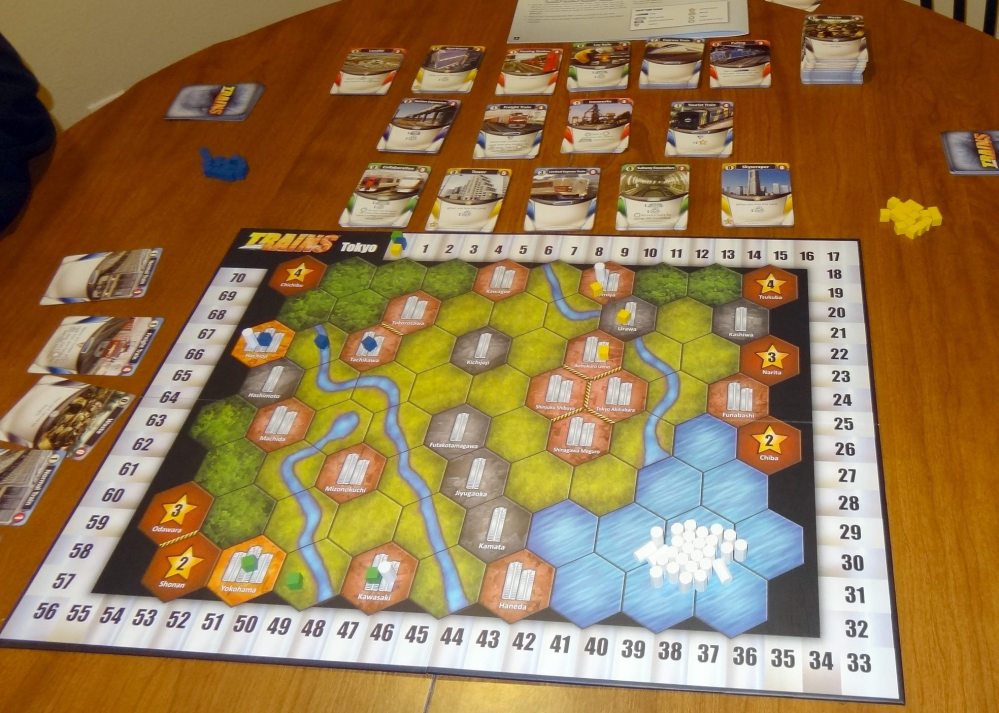
Trains was one of AEG’s big releases this year, and I’ve finally gotten a chance to sit down and play it a few times. It’s a great blend of deck-building (like Dominion) and track-laying (not quite like Ticket to Ride), and I have a feeling I’ll be playing this a bit more in the near future.
Overview
Trains is for 2 to 4 players, aged 12 and up, and takes about 45 minutes to play. Retail price is $59.99.
The game comes with:
- 1 double-sided quad-fold board
- 84 wooden cubes in 4 colors (80 for rail tokens, 4 for scoring tokens)
- 30 white wooden cylinders for station tokens
- 500 cards (10 each of most card types, with more of the basic card types and 70 Waste cards)
- 30 randomizer cards
- 40 card dividers
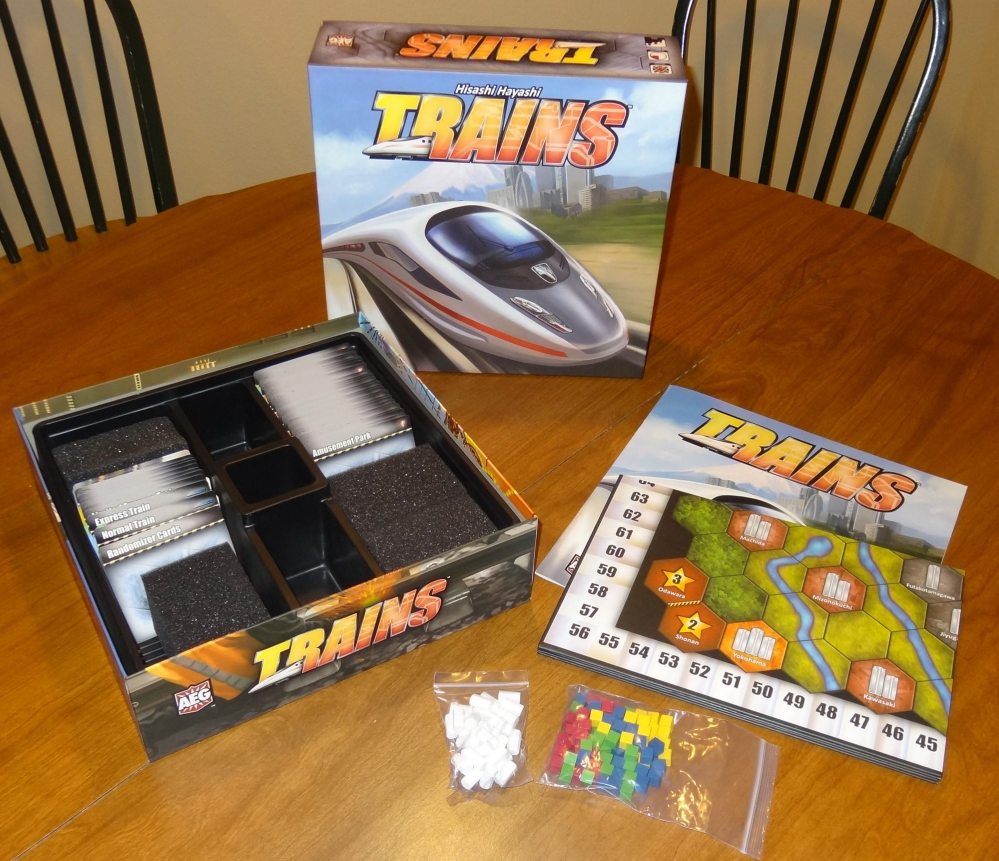
The box divider is one that AEG has used for Thunderstone and other card games: it has two columns for all the cards, plus three other wells that can be used for storing the wooden bits. There’s plenty of room for future expansions, and AEG provides little foam blocks to fill in the space in the meantime. I do like the provided divider cards, which let you easily sort through all the cards.
The rulebook is fairly straightforward and I think should be easy to follow even for players who are new to deck-building, and it will be very simple for those who are familiar with the genre.

I do like the fact that the board is double-sided, showing Osaka on one side and Tokyo on the other. The different layouts give you a variety of ways to plan out your tracks and stations.
The quality of the components is pretty good, but the illustrations and graphic design seem a little plain, in my opinion. With its descriptive-but-uninspired title and looks, Trains might not look really appealing, which is too bad—it’s a lot of fun and definitely worth a try.
How to play
The object of the game is to score the most points, which you do mostly by having tracks in cities with stations, as well as certain cards you can purchase. You’ll use the cards you draw to purchase more cards, build tracks across the map, and build stations in cities.

If you’ve played any deck-building games, you’ll be familiar with at least half of the setup: each player starts with their own deck of ten cards. In this case, it includes 7 Normal Trains, 2 Lay Tracks, and 1 Station Expansion. Normal Trains give you 1 money to spend during your turn, Lay Rails lets you place a rail on the board, and Station Expansion lets you build a station in a city. Everyone takes those ten cards and shuffles them, and draws five cards for their starting hand. You also get all of the wooden cubes in your color, placing one at the start space on the scoring track on the board.

Next, you set up the card supply. There are eight basic card types which are always included (among them Lay Rails and Station Expansion), and you’ll make a stack of each one. The other trains basically give you more money to spend when you play them, and the three gold cards (Apartment, Tower, and Skyscraper) will be worth points at the end of the game but otherwise do nothing in your hand. Finally, the Waste cards take up space in your hand, and are the side effect of doing things like laying rails and building things.

Aside from the basic cards, you’ll also use the Randomizer deck to select eight more card types. These include other types of trains (which give you money and sometimes abilities), cards that let you lay rails (with other bonuses), and action cards. You’ll make a stack of each of these eight cards and then put away everything else.
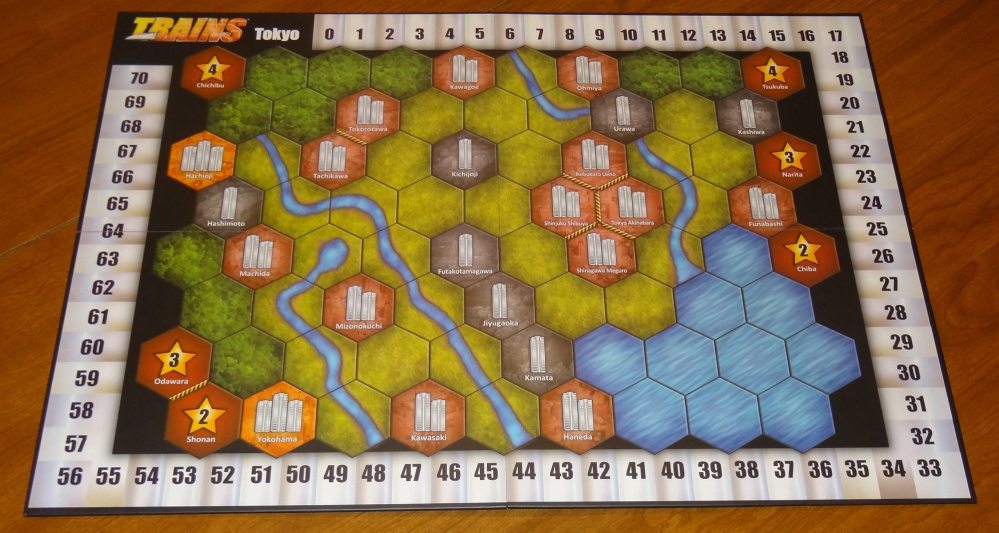
Each player will get to place one of their track tokens anywhere on the board (except where another player already placed). Those are your starting locations, and whenever you lay rails you’ll need to be adjacent to one of your existing rails. Then you’re ready to begin!
On your turn, you can play cards from your hand. Action cards just do whatever they say: draw 2 cards, return all your Waste to the supply, and so on. Trains cards (and some of the other cards) will add to your money that you can spend on your turn. The gold coin in the top left indicates how much money you get when you play that card. But the two most important cards are Lay Rails and Station Expansion.
To use Lay Rails, you play the card, and then you get to add a cube to the board, adjacent to any of your others, and then you’ll take a Waste card from the supply. However, there’s also an associated cost depending on where you’re building: fields are free, rivers cost 1, mountains cost 2, cities cost 1 + the number of station markers already present. And if you’re building where another player already has a track, then you have to pay an additional 1 for each other player’s token, plus take an extra Waste. You must have enough money (from previously-played cards this turn) in order to pay the cost, or you can’t build the track.
Station Expansions let you put one of the white cylinders on any city (whether you have a track there or not), and then you take a Waste. Each city can hold 1 to 3 stations, as indicated by the number of towers on the hex. Here’s why stations are important: at the end of the game, your tracks are only worth points if they’re in a city with stations. The more stations, the more points.
There are also a few spots on the board called “remote locations,” with a number and a star on them. For those, you just pay the cost shown in the number (plus any additional cost if other players are already there), but at the end of the game you’ll earn that many points. No stations can be built in remote locations.
You can also buy cards from the supply if you have any money left over. The cost of each card is in the red circle in the top right corner, and you can buy any number of cards that you can afford.
Once you’ve played as many cards as you want to, you discard all of your cards that you’ve played or still have in your hand, as well as any cards you’ve acquired this turn, and then draw five more. (When you run out of cards, you reshuffle the discard pile.)
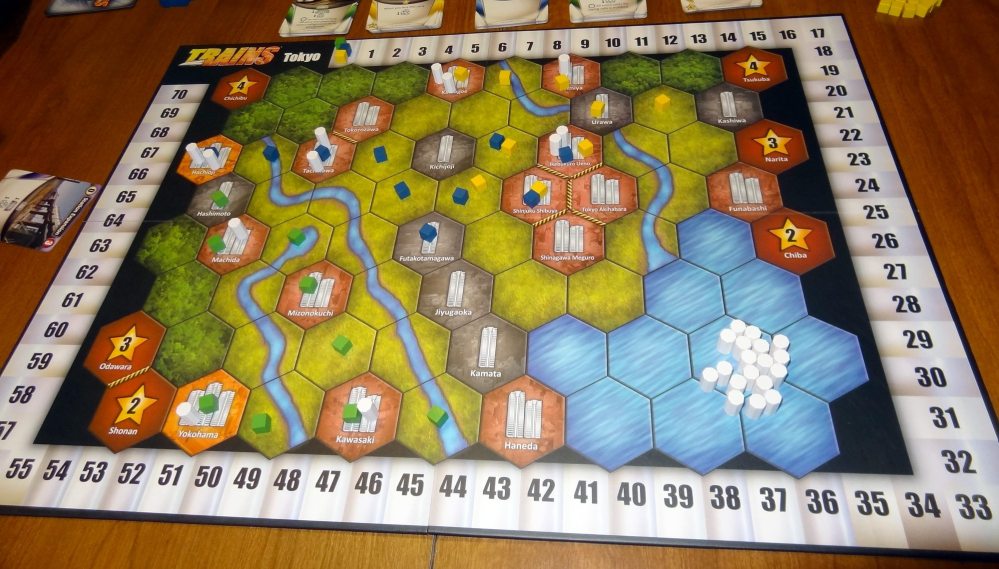
The game ends if 4 of the card stacks in the supply are depleted, or if all of the station tokens have been built, or if a player uses up all of their track tokens.
You score points for each city you have tracks in based on the number of station tokens: 1 station token = 2 points, 2 station tokens = 4 points, 3 station tokens = 8 points. You also get the number of points shown for any remote locations where you have a track. Finally, you look through your deck and discard pile for any of the yellow cards and score points for those (1 for Apartments, 2 for Towers, 4 for Skyscrapers). Whoever scored the most wins!
The Verdict
I’m a big fan of deck-building games in general, from Thunderstone to Dominion to Puzzle Strike to Shadowrift, so Trains wasn’t really a tough sell for me. But one of the things that I particularly like is seeing how various games use the mechanic in different ways, and Trains seems like a perfect blend of deck-building and a track-laying game.
One of the common complaints about deck-building games is the lack of player interaction. Depending on which cards you’re using, many games can feel like each player is playing their own little game of solitaire because few or none of your cards directly affects the other players—the only source of interaction is when somebody else acquires a card before you were able to. In some games, that’s enough for me, but I understand why not everyone likes that.
In Trains, the cards themselves don’t generally affect other players, but because you’re laying tracks on a common board, you have a whole lot of head-to-head competition there. Because it costs more to build where another player already has tracks (both in money and in Waste acquired), there is a lot of jockeying for position and racing to get to valuable cities before other players. If you can build into a city and start putting up stations, it will end up costing another player a lot more money just to share those points with you. But because of the deck-building aspect, it’s not always as easy as just picking a desired path for your tracks—you also have to get the right mix of cards, and that requires careful selection while purchasing cards.
The Waste cards are a great mechanic. Every time you build something, you add more Waste to your deck, and eventually you get crippled by drawing a bunch of Waste in one turn. You can actually take a rest action where you do nothing but dump that Waste back into the supply, but it’s always painful to lose a turn. There are some cards that help you deal with Waste: Landfill lets you return any number to the supply while still taking your regular turn, while the Freight Train actually gives you money for each Waste you have in hand. But even then, there’s always a tension between wanting to build your tracks and stations quickly and limiting the amount of Waste in your deck so you’ll get a better combination of cards in your hand.
I’ve been fascinated with the way that deck-building started off as the game itself (in games like Dominion and Thunderstone) but has evolved into a mechanic that can be used in different ways to accomplish various other end goals (here, to score points by building tracks). Aside from being interesting, though, Trains is a lot of fun. It requires both the ability to spot good card combinations for building your deck well and making decisions about where to build tracks and stations to maximize your score (or, failing that, minimize your opponents’).
If you like deck-building or train games, Trains is definitely worth trying.
Disclosure: AEG sent a review copy of this game.
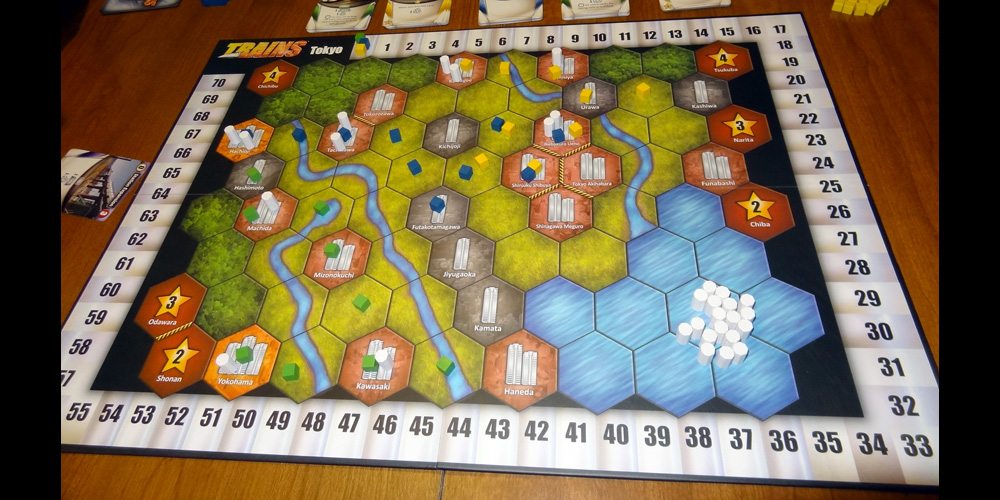




I found your comparisons to deck builders good, but how does it compare to other train games (Steam/Age of Steam/Railways of the World/Railroad Tycoon/18XX games)?
Do you fine the deck building aspect drowns out the train aspect?
Actually, I haven’t played those train games. I’ve only had experience with Ticket to Ride, TransAmerica, and Kings of Air and Steam. The idea that any number of players can build in the same space just for extra costs is new to me, but the racing to build out to specific locations and finding the best route still works well. I felt like the deck-building and track laying go hand in hand; you can’t win just by having good cards in your deck, but you can’t build effectively if your deck is horrible.
Thanks for the reply.
Yeah, any number of players building in the same space just for extra costs is not a normal mechanic for train games (aside from Power Grid, which is basically a train game). I like the balancing aspect you are describing and my family also loves deck builders so we will check this out.
Right—Ticket to Ride has just some limited areas in which multiple players can build, but the rest is about finding alternate routes or using stations to “borrow” a track. This one is about building either around or through your opponents, but it causes more waste on your part and costs more money.